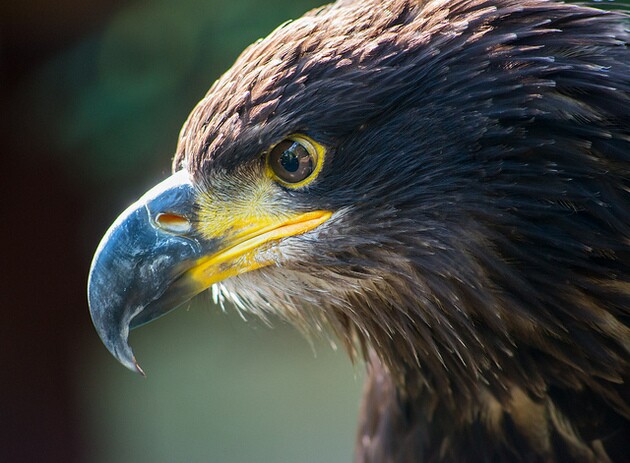Bill Would Gut Major Bird Protection Laws

A bill that would seriously curtail the reach of two major federal bird protection laws has been introduced in the House of Representatives, and its sponsors clearly intend the measure as a boon to the renewable energy industry.
The bill, H.R. 493, would require that the U.S. Fish and Wildlife Service grant permits of at least 30 years' duration to industries that run the risk of killing eagles, a major overhaul of the federal Bald and Golden Eagle Protection Act. USFWS would have just a year to process each permit, and missing that deadline would absolve the applicant of all liability under the act.
A shorter second section of the bill would likely have even more wide ranging impact. That section would change the landmark Migratory Bird Treaty Act to cover only intentional harm inflicted on individual birds, meaning that the law would no longer cover the biggest threats to the hundreds of species the law currently covers.
The bill, introduced January 22 by South Carolina Republican Representative Jeff Duncan, has been referred to the House Natural Resources Committee.
The bill's formal name provides a clear indication that it's intended as a gift to the energy industry. It's called the Clarification of Legal Enforcement Against Non-criminal Energy Producers Act of 2015, or the CLEAN Energy Producers Act. That's an obvious reference to the mounting issue of bird deaths at wind and solar power facilities, though the act's likely largest beneficiaries will likely be oil and gas producers and electric utilities. And it says so right on the tin, in the bill's subtitle: "To update avian protection laws in order to support an all-of-the-above domestic energy strategy, and for other purposes."
As we reported in 2013, oil and gas companies are subject by USFWS to much more stringent enforcement of the Migratory Bird Treaty Act than their wind and solar counterparts, with charges brought against companies over the accidental deaths of single birds.
Likewise, though wind turbines are increasing culprits in the deaths of large raptors such as bald and golden eagles, some of the largest fines levied against companies for accidental eagle deaths under the Bald and Golden Eagle Protection Act have fallen to electric utilities, whose power lines pose both impact and electrocution hazards to the large birds.
USFWS has come under fire from eagle protection activists over the last two years for proposing 30-year eagle take permits under the Bald and Golden Eagle Protection Act. Such take permits would shield wind companies from liability for killing eagles. USFWS had previously suggested take permits of no more than five years' duration, and the longer term is widely seen as a cave-in to industry pressure. But that policy shift by USFWS would have been limited to just the wind industry, at least for the time being, and as agency policy it could have been reversed at the whim of a future USFWS Director.
H.R. 493 would write that 30-year take permit tenure into the Bald and Golden Eagle Protection Act, removing USFWS's ability to reduce the length of future take permits even if it turned out the longer permits were bad for eagles. It would also make those long permits available across the board, to all industries -- including electrical utilities.
As for the Migratory Bird Treaty Act, H.R. 493 would radically change the scope of the law by adding just three words to the Act:
Section 6(a) of the Migratory Bird Treaty Act (16 U.S.C. 707(a)) is amended--(1) by striking "shall" the first and second place it appears and inserting "shall with intent knowingly"
As now written, the act makes it illegal to cause harm to any of the 800-plus listed bird species. The law has been used, if unevenly, to force companies to conduct their business in ways that pose less risk to birds, as in the case of prosecution of an oil company for the death of a single Say's phoebe in an oilfield lagoon in North Dakota.
When it was first passed in 1918, the Migratory Bird Treaty Act was aimed at hunters, especially those who intended to sell the birds to milliners and others. Those days have passed, and now the largest threats to North America's migratory birds are the inadvertent ones: power lines, urban plate glass windows, pesticides, and outdoor cats being among the leading causes of bird deaths.
Outdoor cats aside, most avoidable deaths of birds protected under the Migratory Bird Treaty Act can be traced to decisions made by corporations, whether those decisions are to build oil lagoons without protective netting, to build housing developments in protected bird habitat, or to build large glass buildings that pose serious collision risks to small birds.
As Duncan's bill would rewrite the act, those corporations could only be held liable for bird deaths if USFWS could make a case that the corporation knew those particular individual birds were at risk and intended to cause them harm. That would render the act almost completely powerless to protect birds against modern-day threats, and those threats are currently estimated to kill somewhere between three and six percent of the nation's breeding birds.
According to the Center for Responsive Politics, oil and gas industry interests were the leading contributors to bill author Jeff Duncan's 2014 campaign, plowing more than $51,000 into the Congressman's war chest. Electrical utility interests ponied up another $17,050.
We'll be tracking this bill as it makes its way through the House. Given the Republican takeover of the Senate and the Obama Administration's general apathy over protecting wildlife from energy development, H.R. 493 will bear watching closely.


